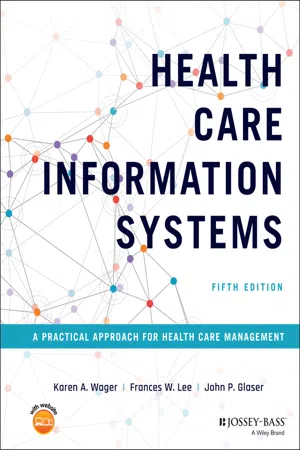
Health Care Information Systems
A Practical Approach for Health Care Management
- English
- ePUB (mobile friendly)
- Available on iOS & Android
Health Care Information Systems
A Practical Approach for Health Care Management
About this book
In the newly revised Fifth Edition of Health Care Information Systems, veteran healthcare information management experts and educators Karen A. Wager and Frances Wickham Lee, along with nationally-recognized leader in health information technology, John P. Glaser, deliver a one-stop resource for graduate and upper-level undergraduate students to gain the knowledge and develop the skills they need to manage information and information systems technology in the new healthcare environment.
The latest edition sees its focus shift from the adoption of health care information systems and electronic health records to making effective use of health care data, information, and systems and optimizing their impact. New additions to this celebrated text include:
- Explorations of how health care information systems and information technology can be used to support national quality initiatives, value-based payment, population health management, and precision health and quality reporting
- Discussions of how issues like interoperability, electronic health record usability, and health IT safety are being (or not being) addressed
- Treatments of the roles played by data governance and analytics in clinical decision making and healthcare operations.
Filled with case studies, supplemental resources, and engaging examinations of critical areas in health care information system use, management, implementation, and support, Health Care Information Systems is an ideal reference for students taking courses in business administration, public health, health administration, medicine, health informatics and health care management.
Frequently asked questions
- Essential is ideal for learners and professionals who enjoy exploring a wide range of subjects. Access the Essential Library with 800,000+ trusted titles and best-sellers across business, personal growth, and the humanities. Includes unlimited reading time and Standard Read Aloud voice.
- Complete: Perfect for advanced learners and researchers needing full, unrestricted access. Unlock 1.4M+ books across hundreds of subjects, including academic and specialized titles. The Complete Plan also includes advanced features like Premium Read Aloud and Research Assistant.
Please note we cannot support devices running on iOS 13 and Android 7 or earlier. Learn more about using the app.
Information
PART ONE
Foundational Concepts
CHAPTER 1
Evolution of Health Care Information Systems in the United States
LEARNING OBJECTIVES
- To define health care information systems and health information technology.
- To be able to discuss some of the most significant influences shaping current and future health information technology in the United States.
- To understand the roles national private sector and government initiatives have played in the advancement of health information technology in the United States.
- To be able to describe major events since the 1990s that have influenced the adoption of health care information technologies and systems.
REVIEW OF KEY TERMS

HISTORY AND EVOLUTION
Table of contents
- Cover
- Table of Contents
- Title Page
- Copyright
- Tables, Figures, and Exhibits
- Preface
- Acknowledgments
- The Authors
- About the Companion Website
- PART ONE: Foundational Concepts
- PART TWO: Managing Health Care Information Systems
- PART THREE: Focused Topics
- PART FOUR: Case Studies and Supplemental Resources
- APPENDIX A: Overview of the Health Care IT Industry
- APPENDIX B: Sample Project Charter, Sample Job Descriptions, and Sample User Satisfaction Survey
- Index
- End User License Agreement